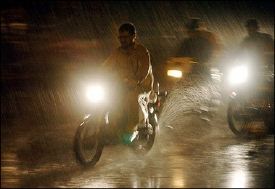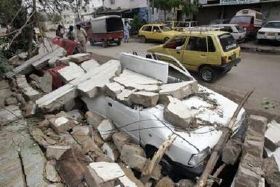Imagine 42 degrees celsius (107 degrees Farenheit) weather, no electricity, no fans, high humidity, no drinking water, and knee deep water on streets. Now imagine living through that for more than 24 hours. Terrible!
 That is precisely what most Karachiites have been going through for more the past 2 days. A huge monsoonal storm hit the city yesterday, followed by torrential rains. And then the infrastructure of the city that had already suffered several major blows in the past 2 months simply came crashing down. The city now sits in a giant puddle, surrounded by fallen trees, billboards, traffic lights, and rooftops.
That is precisely what most Karachiites have been going through for more the past 2 days. A huge monsoonal storm hit the city yesterday, followed by torrential rains. And then the infrastructure of the city that had already suffered several major blows in the past 2 months simply came crashing down. The city now sits in a giant puddle, surrounded by fallen trees, billboards, traffic lights, and rooftops.
Due to the severity of the storm, several trees were pulled out of the ground and are now left stretched across streets, many large bill boards fell on top of passing cars and people, electricity wires were found dangling from the poles leading to several people dying of electrocution, roofs of poorly constructed homes fell killing the residents, rain-related traffic accidents led to further deaths, and now people are suffering without electricity and proper transportation in the maddening heat. Reports are indicating that more than 50 people have died and more than 200 have been injured in Karachi already in the aftermath of the storm. Even those who have lived in the city and watched many monsoons go by are claiming this storm to be among the worst they have weathered. It seems the first wave of the storm has passed by but the city is still struggling to play catch up from all the destruction that it caused.
Karachi has suffered every year in the summer – but this summer has truly been an exception. Loadshedding, whereas practiced for at most a few hours a day in other parts of the country, has been extended to over 10-12 hours each day in Karachi. At least in one part of Karachi, Gulshan Iqbal, residents have had electricity for barely 3-4 hours in the past 48 hours. They have run out of clean water and people are borrowing water from their neighbors who have electricity generators to operate their underground pumps. If one was to take a chopper and fly above those areas at night, one would see most rooftops dotted with chaarpaais. People are routinely taking to the roofs at night to find some air to sleep in.
It is no surprise that there are agitated demonstrations on the streets in almost all parts of the city, resulting in burning of maintenance vehicles, other cars, and of KFC franchise stores. Those with job i n the morning are barely getting a few hours of sleep each night, those living in tall flats and apartments have no roofs to go to, the sick and the elderly are suffering, and food/milk is rotting in their refrigerators. Even those with some influence are suffering. Portable electricity generators have given up in this heat. Others simply can’t afford one that can power major equipment, or can’t afford the fuel to run them 10 hours a day. Given the generator usage in the past month or so in Karachi, I would certainly want our environmental monitoring stations to report the increase in carbon monoxide, ozone and particulate emissions in the city.
 Where is the administration amidst all of this mess? There have been pronouncements on TV (it is strange that due to the electricity shortage, I am able to have better access to news on Pakistan TV stations while living in the US than my own family that lives in Pakistan) that the City Nazim has established an emergency cell in his office, but results are yet to be seen. When residents of one area drove to the nearby KESC office to at least learn when to expect the electricity back, they found a big lock outside the door. Fearing their lives, and having no real plan of action, many KESC workers have fled the offices.
Where is the administration amidst all of this mess? There have been pronouncements on TV (it is strange that due to the electricity shortage, I am able to have better access to news on Pakistan TV stations while living in the US than my own family that lives in Pakistan) that the City Nazim has established an emergency cell in his office, but results are yet to be seen. When residents of one area drove to the nearby KESC office to at least learn when to expect the electricity back, they found a big lock outside the door. Fearing their lives, and having no real plan of action, many KESC workers have fled the offices.
Here is what Dawn had to report on the electricity situation:
According to sources, fire broke out in Orangi grid station neutralising seven other grid stations that plunged major part of the city into darkness. Gulshan-i-Iqbal, Gulistan-i-Jauhar, Federal B Area, North Karachi, Orangi and the adjoining areas remained without power for several hours. This was in addition to sniping of wires and uprooting of electric poles in many localities.
In addition, KESC faced generation shortage as its flagship Bin Qasim was generating only 595MW by sunset and Korangi Thermal Power Plant along with Tapal were off. Supply from Hubco was also interrupted due to tripping in Valika. Owing to this the KESC was only receiving 270MW from WAPDA from Jamshoro Circuit instead of 700MW. The KESC Director Operations claimed that grid stations and feeders had been closed to protect the system from rains.
With the first drop of rain the KESC shut down its 35 grid stations and more than 400 feeders, 30 per cent of the feeders were closed due to tripping while the rest were closed as a precautionary measure. The KESC Director Operations claimed that except for 10 grid stations all were reactivated. But the areas served by the reactivated grids were still in darkness. “This could be due to local faults,� he claimed, however, he had no answer as to who would rectify those faults.
While uprooted poles, broken electric wires were lying on roads, the KESC was still unable to identify them and take measures to secure the area.
Is is shameful that in the largest metropolitan city of the country, people are having to live in these conditions. Everyone that I speak to is on the verge of giving up hope for the city. It appears the administrative system has collapsed, or has been rendered unable to do much in terms of providing relief. The nature and cause of the massive electricity shortage is a topic of another post all by itself, but right now there is a great need for emergency efforts to make sure the elderly, the children, and the ill are provided care in these difficult times. The weather is playing havoc, and the lack of basic amenities is multiplying the suffering.




















































Bilal,
ive seen your profile on your links and I believe you can do a lot in the Pakistan’s Energy sector, either through your company’s business or individually. I am a layman in the energy sector so cant say much but ive seen university students demonstrating prototypes for alternative energy sources. Any thing we can do to generate power, even if on a smaller scale?
In the software community we have something called open source, do u have any companies in the energy sector providing free information on this line of business? Coupled with suppliers for the equippment, like solar panels…
This government never had vision and that’s why they never planned for this day. They are in power for eight years. they even didn’t estimate the needs of people in next eight years. Local goverment is also in category and never realized the future power and water needs of Karachites.
Now they should start to explore the energy resources and come up with ten years plan.
I hope educated karachites will keep current government’s KARKARDAGI and punish them in comming elections.
The top wind was 60 miles/hour. People died because first there was no warning and second those who live in “kachi abadi” died of collapsing roof.
Where were “GEO” and “AAJ”? Why they don’t gave ppl warning that what 60 miles/hour wind is capable of. These media is too busy in showing political debate. In that country everyone either talks about politics or condeming USA, Britan.
Do any of our poltical party has any plan to solve real issues?
I called home yesterday and heard this from my mother. We had a ‘jaman’ (don’t know the English word for that) tree in our neighbors house for 30+ years. All of my siblings grew up eating its fruit year after year. In 30 years, it had weathered so many monsoons, storms, rains etc but yesterday’s storm in Karachi proved fatal for it. It lost all its branches. Only trunk remains standing. It may/may not survive. but point is yesterday’s storm was really unheard for in intensity of winds before.
This is insanity. Till the day that administrators are fed from the same power lines, admitted to the same hospitals and send their children to the same schools as the rest of the common folk, nothing will change.
Every citizen of Karachi dreads the summer months because of this. Yet the administrators seldom have the foresight to plan ahead and always seem to be chasing after bolted horses.
While those higher up in the food chain are content with offer condolences and monetary relief packages, no one seems to be interested in saving lives and providing basic civic services.